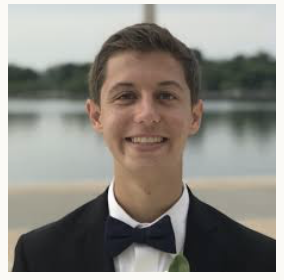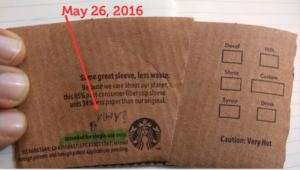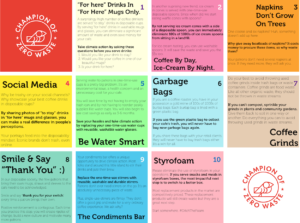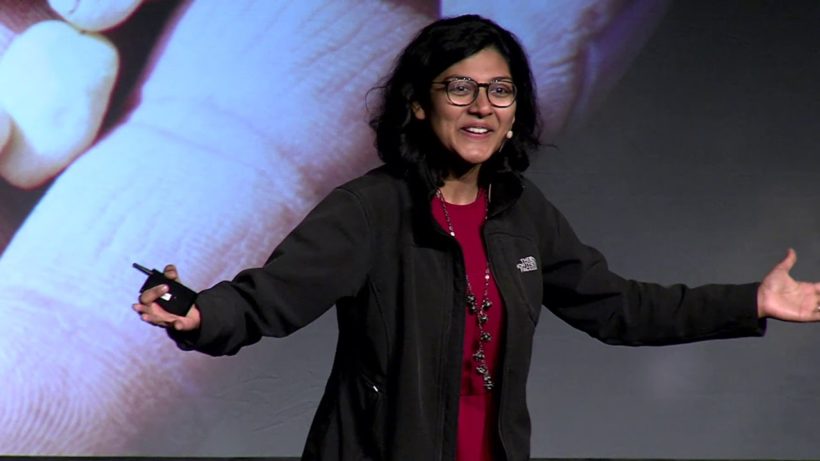 Matthew Capuano-Rizzo
Matthew Capuano-Rizzo
Design by Freedom founder and CEO Anukampa Freedom Gupta-Fonner on her inspirations, the Freedom Sleeve 2.0, intersectionality, and zero-waste during COVID-19.
Some claim America runs on it. Many ask that others not speak to them until they have a cup. When we think of the busy business people running to work, they almost always are grasping a cardboard container with a green lady on it that will hopefully keep them awake enough for the meeting to allow them to keep producing, keep consuming, and keep throwing away. More than half of commuters (56%) drink coffee on their way to work. We are always on the move, always late to something, or at least behind on where we should be. But as we are running around with our granola bars, trail mixes, chips, plastic water bottles, and other conveniently packed items, we are leaving something behind: trash. Each day, the average American generates 4.51 pounds of waste. That adds up to 25.9 metric tons of waste per person per year, third in the world.
Coffee is warm, comforting, welcoming–but it’s also wasteful. Let’s just focus on the sleeve. If we examine the sleeve of our favorite green lady, we will see a small bolded phrase in the bottom left corner that says ‘Intended for single use only’ following a larger, more prominent paragraph about the company’s recycling efforts. Now this may not come as a surprise to many of us as we may think ‘Who has time to hold on to a cardboard sleeve?,’ particularly in our fast-moving world. But what if that sleeve was ten different colors? What if it could attach to your bike, your keys, or your water bottle, what if it was compostable in your garden after a year of use instead of discarded in your trash can after just one single use?
That is the idea behind Design By Freedom’s Freedom Sleeve 2.0: to eliminate disposable coffee sleeves by replacing them with a fun, convenient alternative. While the little sleeve may appear insignificant in comparison to the massive amounts of trash we generate each day, each year and over the course of our lifetimes, 40 million coffee sleeves are thrown in the trash every day in the United States, amounting to 2.8 billion pounds of wasted paper each year. The Freedom Sleeve is just the beginning of Design By Freedom’s mission to #MakeTrashHistory by partnering with coffee shops across the country on zero waste supply-chains initiatives. I sat down (over Zoom) with the imagineer who created this project to learn more.
“[Coffee] is a tool that can leverage and drive conversations, and sometimes even really hard conversations.”
Matthew: Where did your interest for the environment begin? Do you have any formative childhood or adult experiences that led you to pursue Design by Freedom?
Freedom: There’s a little bit more depth to it. In the formal sense, Design by Freedom was started just a few years ago, but the work has been happening for a long time. I have been passionate about the environment since I was a little girl. I had two favorite trees when I was five years old and I called them ‘Elephant’ and ‘Camal.’ The love for nature has been an unwavering and unequivocal quest since I was very young.
When I was in high school, and later as an undergraduate student, I used to volunteer for animal rescue groups. As an undergrad, I started another environmental club to save trees from being deforested. A lot of those experiences, including learning about public policy and working as a journalist, convened into a simple point in time where I began to ask: ‘What is the most impactful thing people can do for the environment?’
The answer to that question is: eliminate trash. [Trash] touches every aspect of our living experience. You can be a tree-lover, you can be somebody who’s saving whales or elephants, but if at the end of the day, your everyday impact trumps all those activities, that’s a huge problem. That’s why we focused on this concept of everyday waste in peoples’ lives, and how we can make it zero.
M: What led you to focus on coffee for your zero-waste efforts?
F: It was really simple. It was because my husband and I love coffee. The ability of this little drink to foster connection, to bring human spirits together, is powerful. [Coffee] is a tool that can leverage and drive conversations, and sometimes even really hard conversations. Think of how people come together over coffee. They could be discussing business, they could be discussing first loves, this could be a date, this could be anything! Coffee is a galvanizing force in our culture, which has the ability to bring people together. Our journey towards zero waste started with a very simple concept: the coffee sleeve. If you look at a Starbucks coffee sleeve, there is a statement listed behind the cardboard sleeve, which says “This product is intended for single-use only.” I wanted to challenge that idea. I used that one cardboard sleeve for over six months across 13 different states. I just used it everywhere. I kept it in my pocket. I kept it in my diary. It was always travelling with me because the curiosity was to just understand ‘Why is anything single-use only?’ So that’s how our [my husband’s and my] passion for the environment came together through coffee.

The famous coffee sleeve that survived Freedom’s 6-month cross-country journey. –Anukampa Freedom Gupta-Fonner
M: How is the Zero-Waste Cafe Collective progressing?
F: Great question and it’s a difficult question right now. If you have noticed, in the current environment, most cafes are not accepting any reusables. That’s a very tragic reality of right now. When we started the Zero-Waste Cafe Collective, the goal was simple: every few months, we will help our cafe partners cut down on one type of trash from their entire supply chain. It’s not just the sleeve, we have a system of reusable mugs. It’s called BAM [Borrow-A-Mug], an entire circular economy reusable system whereby instead of giving your customers a single-use cup, you could give them a reusable mug by default. There is a system that is built in for this customer to return your mug. We have worked on other things like removing single use sugar bags from the supply chain, [replacing that with] bulk sugar in a jar. We removed single-use stirrers. We also built the Climate Action toolkit for cafes. Asking this question in a COVID era adds a lot of complexity to it. None of the cafes are following any kind of reusable protocols [during the coronavirus pandemic]. They are right in their reasons. Everybody is so scared to spread the virus that they’re not not willing to believe, even when a customer is bringing in a reusable mug, that the mug is clean. We’re in a very tricky time.

Design By Freedom’s Cafe Climate Action toolkit
F: I think the point I want to most emphasize is the assumption that disposables are cleaner than washed and sanitized reusables. We can’t take that notion for granted. Imagine if you are a cafe who is implementing a reusable mug program, you might actually be doing a better job [giving your customers safer products] rather than [giving customers] a disposable cup that just came out of the factory and has not been sanitized. So you are assuming that in the supply-chain, what you are getting is actually clean and is good for human consumption. We’re not even thinking about microplastics. We’re not even thinking about anything! It’s a tricky question for right now. Alot of progress has been reversed. It’s like going back to the basics. We [Design by Freedom] is looking at where we can we reignite the conversation. That’s where the Freedom Sleeve does a very good job of keeping the idea of reusables alive. You don’t have to give the sleeve to anybody. As a customer, you are literally just bringing it with you. There is nobody collecting it from the other side. There is no touching or exchanging this. I think that’s where we need to keep the idea of reusables alive.
“Intersectionality is at the heart of our work.”
M: Do you see an intersection of the Freedom Sleeve and Design by Freedom with larger systemic issues such as environmental injustice, the concentration of pollution in minority communities?[e][f]
F: Absolutely. I’m glad you bring this up. This has been a powerful question in our own psyche. We started putting together a ‘living essay’ about [Black Lives Matter] on our main website. The goal of this ‘living essay’…I’m calling it a ‘living essay’ because it’s not like we have written about it once and then we’ve forgotten that it exists, the goal is to update it with every single opportunity we get. [We plan to update the essay with] ideas that we are presenting, names of people who have lost their lives, even going back twenty years. We are still figuring out names from 2020, but this is a deep issue. Intersectionality is at the heart of our work. I will give you a very concrete example. Trash impacts lower income communities, BIPOC [Black, Indigenous, People of Color] people, a lot more than higher income communities. To the Freedom Sleeve, we actually want to create fundraisers just like the current fundraiser to save the elephants (the 10 Super Tuskers of Tsavo). Within that, there is an even more precise example. If you have heard of the move ‘There’s Something in the Water,’ a great environmental film, the first story that is shared is from Canada. It is the story of a Black Canadian community where their water gets polluted from burning and dumping trash in their community. How many people in that community have gotten cancer? How many people in that community have lost their lives? It’s totally disproportionate! So to say that intensectionality between environmental justice and racial justice and economic justice doesn’t exist would be such a missed opportunity. So when we choose our campaigns, just like our campaign for saving the elephants, those are the kind of partners we want to collaborate with: communities that have felt the brunt of this problem.
In the movie, there’s actually an example where the Black Canadian community is demanding that the local government put a well in the community so they can drink clean water. The well costs $10,000, but the local gov unwilling to invest that money in the health of the people, just because of who they are, how they look and what their background is. [The film] makes a comparison: the same year, the local government spends $35,000 on a parade, but they couldn’t make the $10,000 well? Imagine using the Freedom Sleeve as a tool to propel broader social change. The first 5 days of the month, we donate 100% of our revenues to our partners and the next 25 days, we donate 25% of our revenues to our partners. That’s the kind of product that we’re working to built. That’s how there’s a really direct connection. Broadly there is a connection with the injustices, but there is a direct connection also with the type of partners that we choose for our work.

The Freedom Sleeve 2.0 –Design by Freedom
M: If you are donating such a significant portion of your revenues to all of these worthy causes, are you able to cover your costs?
F: We are not giving money away. This is not a blinded way of trying to do good. There is a deeper strategy here. There is a deeper financial sustainability element to this. Think about the 1% for the planet movement. There are so many brands that say they will donate 1% of their profits to a cause. Now these are really big corporations, so I understand that 1% is a lot of money, but think about how corporations do their accounting. When it is actually reported we don’t know what is 1% of the profits.
As a small business, when we talk about donating, this is about making a statement that we are in this to do good. There is a lot more meaning and depth to those words. As a organization that is making a product in the United States, using materials that are made in the United States, we’re able to say that we donate 25% of our revenues. That comes to about $3.25 on every sleeve that is sold. The power to do good is so immense, yet the biggest organizations will only donate a small amount. So for us, this is not about wasting money or being financially unsustainable. This is about ‘How do you make a boldstatement, while being ethical? With respect to sales, the next few months will be absolutely critical. When we are saying the first 5 days we will donate all of our sales, we can use the next 25 days to balance that out. We plan to raise a certain amount of money over the course of a month. As a social enterprise, we look for where we can do the most good and at the same time be a financially sustainable organization. We’ll find some of those answers in the next few months. We just launched this [the Freedom Sleeve] again.
“We are looking at where we can make a strong move.”
M: Design by Freedom’s next invention is the Borrow-A-Mug (BAM) Cup. What is your goal with this product? Where are you looking to go in the next few months, years?
F: BAM was actually supposed to launch in April of 2020 with the SCA, our partner. Because the pandemic hit hard, [the SCA] cancelled the entire expo. When we launch BAM, ‘What’s the plan with it?’ ‘What’s the goal?’ The sleeve is only one part of this mision to make trash history. There are so many other components to it. The mission of BAM is to get rid of single use disposable cups. We plan to get rid of them in two different types of environments. The first environment is a closed loop environment like a conference, where so many people are coming together. Over the course of just a few days, they end up using 600,000 to a million single use cups. So [we are] building a system where there is ready washing, ready sanitizing stations available and people can literally return their mug and get a clean one. Think of it like a library where you can check in and check out a mug. You are doing this in a conference setting. The broader goal with BAM is to remove single use mugs from coffee shops. What does it mean to have BAM in your cafe? The biggest innovation with BAM is that we can implement the system with any kind of mug. You don’t have to buy the mug from us. Let’s say you’re a cafe and you have an inventory of 2,000 mugs with your branding on it. As a cafe, whatever inventory you currently have, we can use that to make a reusable system for you. You can give a cup of coffee in a real mug, rather than a single-use cup. Your customer can be held accountable when they return it or when they do not. It works on a QR code technology. Just like a library book, except it’s washed and sanitized.
The behaviors during COVID [could be consequential]. If cafes are unwilling to accept customers’ mugs, the best thing they can do is use BAM. [With BAM], you are able to give out your own mug and then when the customer comes to return the mug, you have an opportunity at a long-term customer because if they come to return the mug, you can make them a new drink in a new mug! So we’re looking at their revenues, we’re looking at their sales, a lot of things that might just be a stop thing for somebody, but just because they are part of a bigger program, they may want to come back again. For example, I don’t want to go to a coffee shop unless they have a reusable mug program. Like I haven’t gone to a coffee shop in four months! I don’t want to be drinking single-use disponsible. If they won’t accept my mug, will they be able to give me a mug of their own that they know is washed and sanitized?
So we are looking at where we can make a strong move. We need a willing partner to make the move and we need the willingness of people to participate. So many people in the coffee world are struggling financially. Risk taking is at an all-time low. Doing anything new is at all time low, but we’ll be watching. There will be an opportunity and we’ll be watching. [g][h]
You can purchase Design By Freedom’s Freedom Sleeve 2.0 on their website! 25% of your purchase will benefit the Tsavo Trust, whose Big Tusker Project protects the last ten Super Tusker elephants in Tsavo, Kenya in addition to nearly 13,000 other elephants and 18% of Kenya’s black rhino population. After purchasing the sleeve, you can learn more about how to embrace a zero-waste lifestyle (Refuse, Reduce, Reuse, Compost, Recycle).
Matthew is currently pursuing his studies in sustainability at Columbia University.



Leave a Reply